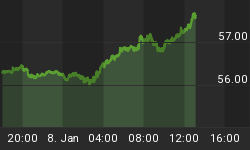Last month we concluded that given the oversold nature of the market, support at 1955 should hold, and the SPX should continue making new highs. Since then 1955 was tested twice and held, and the SPX went through two overbought/oversold cycles, making marginal new highs on both occasions:
The DJIA and the NDX made new highs as well.
Which brings us to the Russell 2000 index which made a new high at the beginning of July, but since then is lagging behind the other majors. Looking at the monthly chart, it is actually showing a textbook momentum divergence -- a double top accompanied by lower stochastic readings:
The first level of support for the Russell ETF is at 112, and the next at 107. Any break below these levels will put the chances for continued advancement of the other indices in serious doubt.
It is interesting to note that to construct the Gann angles for the IWM we used the combined input from two of OT Signals' new indicators: Swing Time and Swing %. They measure the average swing duration and average % swing advance/decline for your instrument of choice. Then it's just a matter of using these numbers to mark price and time targets, or plugging them into your favorite TA tools, and eliminating all the guess work.
Gold briefly broke above the 50% retracement level of the '09 - '11 bull run following the MH17 crash, but was unable to hold on to the gains, and is testing old support levels dating to April '14. Just like before, we can't get bullish unless it breaks above that 50% retracement. And, unlike GS, we see long-term support for gold at 930, and not at 1050:



















